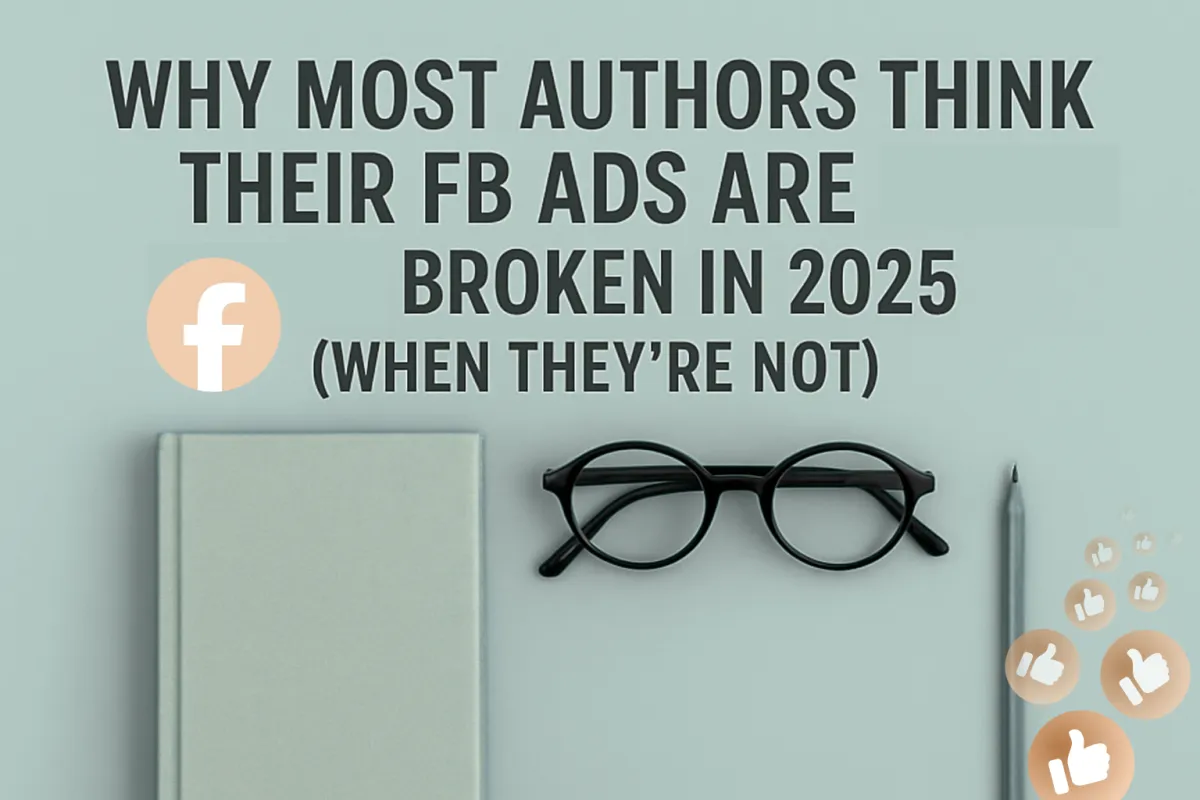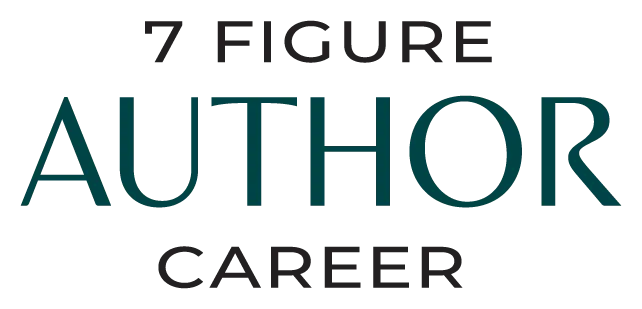
Why Most Authors Think Their FB Ads Are Broken in 2025 (When They’re Not)
“My Facebook Ads Aren’t Working.”
We hear it all the time: “Facebook ads don’t work anymore.” But that’s not true. The ads are working exactly as they should, the problem is that most authors don’t understand what their results are really telling them.
The truth is that ads don’t fail in isolation. They fail because the business behind them isn’t structured to support success.
Before an ad can perform, everything it connects to has to be solid. The product, the positioning, the reader experience, and the data flow that tells you what’s really happening. When one of those elements is off, the ads expose it. They amplify what’s already there, good or bad.
So when ads underperform, they’re not “broken.” They’re simply reflecting what’s happening beneath the surface.
Ad Accounts Are Like Children: Train Them Early
Let’s start with the ad account itself. When you first create a Facebook Ad Account, it doesn’t trust you yet. You get limited spending power until you prove you can handle more. That’s Facebook’s version of responsible parenting: it gives freedom gradually, based on good behavior.
But what most authors don’t realize is that they’re teaching their ad account how to behave every time they run an ad. If you let it spend at high CPC, Facebook assumes that’s fine. It learns that you’ll tolerate inefficiency, and it keeps testing your limits.
It’s no different from raising a child. You wouldn’t wait until they were a teenager to start setting rules and expect obedience overnight. You’d set boundaries early and reinforce them consistently. The same applies here.
Set your limits. Define your standards. Revisit them often.
Training your ad account from the start saves you time, money, and frustration later, and ensures that when you do scale, your account already understands what “good behavior” looks like.
Campaigns Grow, Peak, and Fade: Just Like People
Every ad campaign has a life cycle. It’s born, it grows, it peaks, and eventually, it fades.
Some ads mature quickly, performing beautifully from the start. Others stumble through awkward phases before finding their stride. Some hit their peak early, and some take longer to develop.
That’s not a failure, that’s natural progression.
When an ad stops performing, it doesn’t mean ads “don’t work.” It just means the campaign has reached its natural end. The solution isn’t to give up on advertising altogether, but to replace and refresh consistently.
Think of your ad account as a planet and your ads as its population. As old campaigns “die,” new ones must be born to keep the ecosystem thriving. Ignore that balance, and you risk extinction, a stagnant account with no data growth or creative testing.
To understand when to replace or refresh an ad before it declines, check out our detailed breakdown in How Often Authors Should Refresh Facebook Ads. It expands on creative rotation timing and scaling strategy in more depth.
And before you retire an ad completely, make sure it’s truly done performing. Many authors mistake a quiet period for decline when in reality, their readers are still moving through the decision process. We call this The Delayed Buyer Effect, a behavioral pattern where readers see your ad, plan to buy later, and finally convert days or weeks down the line.
At the same time, you don’t want overpopulation. Running too many ads without structure leads to chaos and poor data signals. The balance lies in maintaining a healthy rotation: creating, testing, replacing, and refining at a steady rhythm.
The Product Problem: Ads Can’t Fix What Isn’t Working
The most common mistake authors make is assuming ads can sell anything. They can’t.
Ads amplify the truth of your product. If your book isn’t appealing to readers. For example, if the cover doesn’t fit the market, the blurb confuses, or the story pacing drags, your ads will simply broadcast those problems faster.
You lose sales when readers sense the product isn’t what they’re looking for before purchase.
You get refunds when they find out after buying. And you lose future readers when what you promised in the ad doesn’t match what they experience in the book.
This is why we emphasize that product and advertising are inseparable. One cannot compensate for the other.
We’ve seen it happen repeatedly: when authors strengthen their books, through sharper blurbs, stronger editing, or better packaging, their ad conversions rise immediately, even when the ad creative, targeting, and spend remain identical. Our programs, developed by international bestselling author and author coach Rebecca Hamilton, have consistently shown that improving the book itself (cover, blurb, pacing, positioning) increases ad profitability more than any targeting tweak ever could.

Conclusion to this: the ad isn’t broken, the product just wasn’t ready.
Beware the “Ad Expert” Who Doesn’t Understand Books
Not every advertising strategy translates to fiction.
Facebook’s platform is optimized for traditional eCommerce, tangible products with short buying cycles. Books, on the other hand, are emotional investments. Readers don’t click “buy” because of impulse; they buy because of connection.
That’s why many of Facebook’s automated recommendations, like “Advantage+” targeting or Multi-Advertiser placements, underperform for authors. Yes, they may lower CPC, but cheap traffic means little if it doesn’t convert.
We’ve seen clients shift budgets into these features and watch costs drop, but profits disappear. When we revert to the structure built specifically for fiction, ROI returns.
It’s not about outsmarting Facebook’s AI. It’s about understanding reader psychology and the nuances of how stories sell. That’s why we teach advertising not as a generic formula, but as part of a complete system, one that takes into account how books are discovered, purchased, and remembered.
The Bigger Picture: You Don’t Have an Ad Problem, You Have a System Problem
When an author tells us their ads don’t work, they usually fall into one of two categories.
Group 1: Authors who aren’t ready for ads yet.
Their vendor coding, book packaging, or series structure isn’t optimized. Without a strong backend, working links, good read-through, aligned branding, no ad in the world can make those books profitable.
Group 2: Authors who understand tactics but not principles.
They’ve learned how to copy someone else’s targeting or creative, but they don’t understand why it works or how to make decisions based on data.
We’ve seen this transformation in action through our author case studies. From historical romance to paranormal shifter series, where optimizing systems led to higher conversions without changing the ads themselves. Explore our Author Case Studies to see how data-driven alignment can completely reshape results.

Both issues stem from the same root cause: running ads as a standalone fix instead of part of a connected system.
At Seven Figure Author Career, we help authors build that full system, aligning the product, the funnel, and the advertising strategy under one unified framework (what we call the 3xP Method: Psychology, Positioning, Profitability).
When those pieces work together, ads stop being unpredictable. They become data-driven, scalable, and sustainable.
Ads Are the Engine, But You Still Need the Vehicle
A car doesn’t move because it has an engine. It moves because all its parts work together: the wheels, steering, fuel, and driver’s skill.
Ads are the engine.
Your product is the vehicle.
Your audience is the fuel.
And your mindset and strategy are the steering wheel.
You can own the most powerful engine in the world, but if your car has no tires or no gas, you’re going nowhere fast.
That’s why our goal isn’t to just teach Facebook ads. It’s to help authors build the entire vehicle — piece by piece — until it’s capable of running at full speed without burning out.
What It All Comes Down To
When your ads stop performing, it’s rarely the ad’s fault. It’s a reflection of your system: your product, your reader journey, your expectations, and how you train your ad account to behave.
Facebook ads are still the most powerful and scalable tool available to authors today. But they only work when the foundation beneath them is stable.
Train your account early.
Rotate your ads regularly.
Strengthen your product.
And view every metric as feedback from the system, not failure.
If you’re ready to learn how to build that system from the ground up, explore our Seven Figure Author Career Programs or join our Free Author Community for free resources and weekly insights.
Remember ads aren’t the problem, they’re the mirror.

